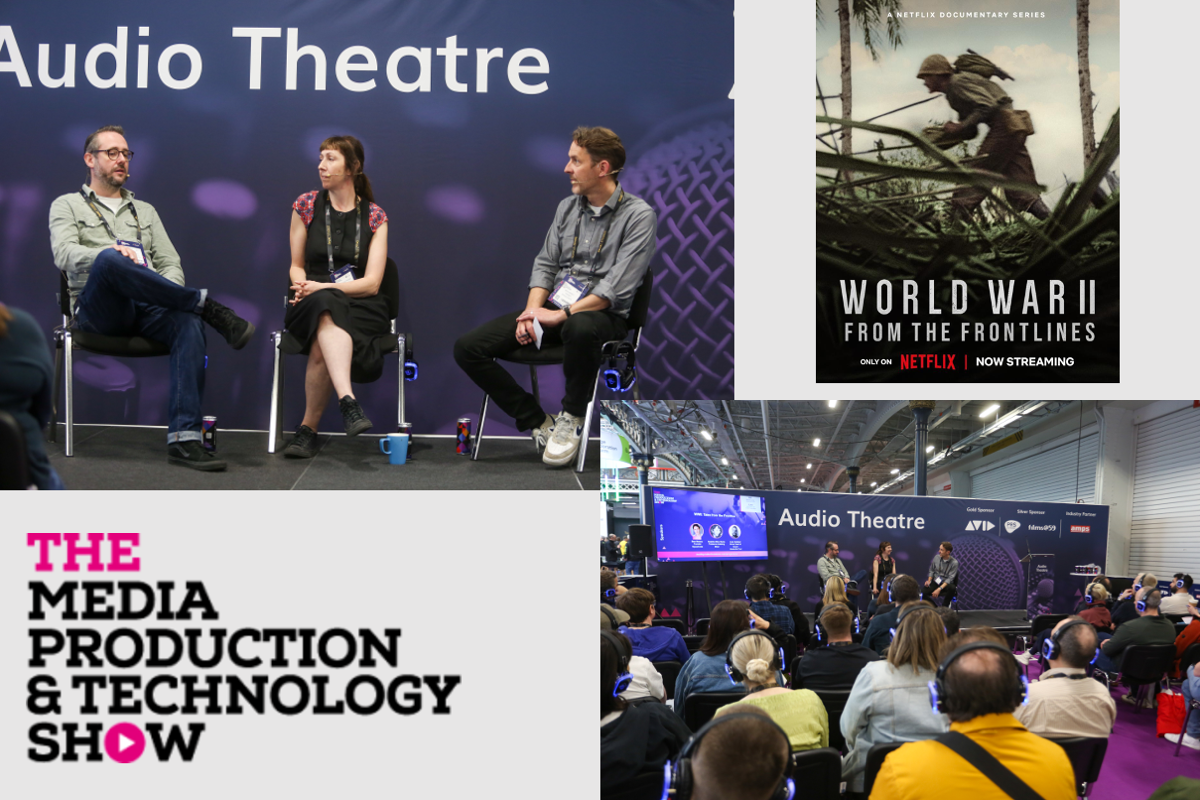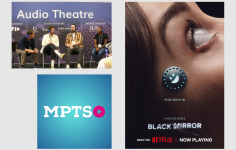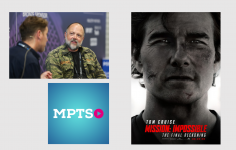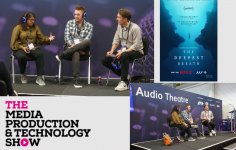At the recent Media Production & Technology Show in London, Resurface co-founder Ben Nemes had the opportunity to speak to Sophie-Alice Davies and Luke Hatfield of Vaudeville Sound about their sound work on the ground-breaking recent Netflix documentary series World War II: From the Frontlines.
A recording, along with a full transcription, of that conversation is below.
Ben Nemes: Well, good morning, everyone. And welcome to session one of day two of the Media Production & Technology show, 2024 here at the Audio Theatre.
So without further ado it’s my pleasure to introduce you to two people and a piece of work this morning.
Before we even get going, quick show of hands. In the audience, how many of you watched, on Netflix, World War II: From the Frontlines? Good. A few. Excellent. We’ll get to that in a second.
So, I’d like to introduce you to two people very much involved in the sound of that show, which is remarkable in a number of ways. So Sophie and Luke from Vaudeville Sound. Welcome to MPTS.
Sophie-Alice Davies & Luke Hatfield: Thank you. Hi.
Ben Nemes: We’ll show a clip in a minute or two, but before we do: One thing I wanted to establish from the get-go is what’s unique about this show.
So on the face of it, you might be forgiven for, on Netflix, browsing through, seeing a six-part documentary series about the entirety of World War II. And it’s lots of archive footage of things, and lots of interviews of people who were there, lots of witness testimony and people as they are now talking about how it was then.
And it seems – on a really superficial level, to be a very good World War II documentary series.
What’s fundamentally different about it, is that everything you see is archive from footage captured in World War II. But everything you hear is completely brand new.
Maybe I’ll let you guys pick up the story on how that process came to be. A very atypical way of approaching something like this as a project. And then when you’ve done that, just to kind of illustrate the point a bit, we’ll show a clip which is from the Battle of Stalingrad, I believe.
But if you can just give us a kind of overview of what you were doing in this show, and how it came to be that you worked with the producers to come up with this way of tackling a World War II documentary series.
Luke Hatfield: Sure. So to start with, when we found out about this project – Because we’ve done a lot of World War II documentaries before – we were expecting to see a lot of the footage you’ve seen before in these World War II documentaries.
And actually, when we started seeing this stuff, it was stuff we’ve never seen before. It was footage they found from people’s attics. It had all been collated and it was it was really unique footage. And then the way it was given to us to be made and put together was very much from soldiers’ and civilians’ perspectives.
So it was a really interesting take on a World War II documentary, which is normally just very factual: This happened, then this happened. And it was very much more of a human story. Very story driven, and the human element of it.
So that was really great and exciting for us to do, because it’s very different to the usual documentaries. I mean, I grew up with the Laurence Olivier ones that were just very stark and factual. And so it was very exciting to have this blank canvas to create these stories.
Sophie-Alice Davies: We wanted the sound to basically put you in that scene. It was important to make you feel like you’re on the tanks. Getting all those sounds, just making you feel like you’re there. It was a different way of thinking.
Ben Nemes: That immersive quality.
Luke Hatfield: Those were the really early discussions with Rob Coldstream, the director.
Ben Nemes: That was my next question. Who said, right, you know what? start from scratch!
Luke Hatfield: So, we went into the edit and they had some temp sound effects and all those sort of things. We sort of made a decision early on that because we are bringing colour and life to these images: Not just using archive sounds, any sort of sounds recorded back then, which are thin and normally full of noise, and all the ‘optical’ sort of sounds.
We wanted to sensationalise it, but bring what you’d expect from a Hollywood type of soundscape. We’re used to hearing Private Ryan and Band of Brothers and all that sort of thing and because the images are going to be so vivid and so new, we wanted to bring an element of the sound to be not jarring against the new pictures.
So again, we’re like, well, so we need to base it in reality. So Sophie did loads of research on the actual tanks, the actual guns, all the ‘actuals’. So we have source material from then, but then we layer it in with modern sound effects, modern techniques. To try and get that balance of reality and entertainment, essentially, as well.
Ben Nemes: It’s an interesting point you make, when you think about your approach to this, because we as an audience have kind of been spoiled now. I mean, opening scene of Saving Private Ryan, it’s kind of seminal. Then look at things like Hacksaw Ridge that won Kevin O’Connell an Oscar, primarily because of the kind of immersive, real, harrowing nature of some of the battle elements of that.
So you have that kind of benchmark now, everyone’s got that burnt in.
But then, the stories you’re telling aren’t all ricochets and flypasts. It’s, as you say, there’s human stories. People getting married, things you didn’t know were happening. The way that the Japanese pilots were being talked to prior to going on Kamikaze missions and things you didn’t know happened because it’s footage we haven’t seen before. It’s not all D-Day.
So there’s that really high bar now in terms of entertainment. But there’s also stories to tell. I think a really good thing to do right now would be to show a clip to kind of demonstrate the point.
So this is, I also want to stress it again (because I don’t think Netflix did a good enough job, quite frankly, of explaining to people, to the audience), everything you’re seeing is archive. A lot of it recolourised, a lot of it treated. A lot of it found in attics, as you say, but there’s precisely zero sound on any of this show until you guys get involved.
So if we could show a clip, this is Episode 3, and it’s the Battle of Stalingrad and the stories around that.
If you come at it with the notion in one’s head, that everything you’re hearing, none of it came from archive.
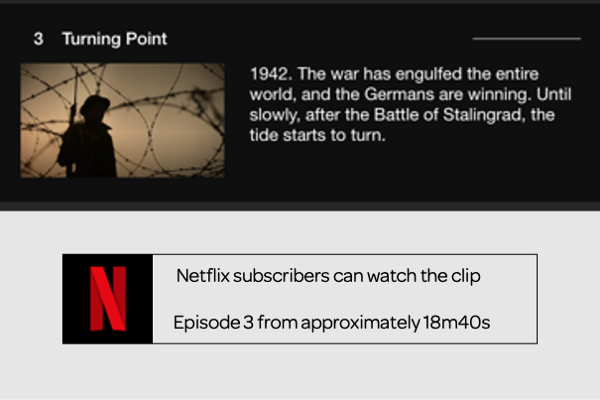
Ben Nemes: I chose that clip, and thank you to Netflix for very kindly allowing us to show it, because there’s something of everything in there. We talked a little bit about human stories and Alexandra’s story is kind of through there.
And there’s the explosions and the firearms and all that sort of stuff. But there’s also all those other layers.
Perhaps this would be a good moment, Sophie, to go into your role in it, because oftentimes you have editorial, you have a separate re-recording mixer role, whether it’s effects, dialogues, foley – and talk about your role in it, and let’s try and maybe pick out some of those food groups within what we just saw.
Sophie-Alice Davies: So my role essentially was to start from scratch and to rebuild all the sound. So normally you would get, or we did actually have a foley artist, but we normally get foley, atmospheres, sound design groups, people that deal with actual sound effects, you know, like opening doors, but my role was to do all of it.
I had about four or five months, on my own, rebuilding all the sounds.
Ben Nemes: And this is six by one hour?
Sophie-Alice Davies: Six part, forty-two to, I think, the last one was fifty-two. So, bar the music being composed and the foley being done for us, I did all the sound effects and sound design and all the dialogue restorations and the voiceover record, and then I mixed all of it together.
So yeah, it was a lot of work, but really good fun actually. And it involved a lot of research on how engines sound… If we can’t get those elements, if we can’t get those sounds because some of the planes were discontinued quite early on in the war, so it’s really difficult finding decent recordings of all of these engines and stuff.
Ben Nemes: You’re something of a Messerschmidt expert now?
Sophie-Alice Davies: Well, it took a lot of research and, you know, you had to kind of bend the rules a bit and go “Right if I don’t have that, then what do I have, and what are people gonna believe?”
It needs to be believable. If it’s not real then it needs to be believable and then that’s when you have to start layering up stuff and manipulating them and making them sound as they should.
Luke Hatfield: And that’s where the director was really great.
‘Cos he was like, I don’t mind if it’s not the exact sound, but it needs to sell that moment. And so that gave us the ability to not use the exact sound but build around similar sound because, ultimately, the purpose is not to be totally accurate. As long as we have some basis in accuracy, we can then build on it.
Sophie-Alice Davies: I mean, planes in films don’t always rev the way they sound, but it fits for the excitement of the scene. And you believe it when you watch it. Important thing is you believe it.
Ben Nemes: I’m curious about your approach in terms of your process. Do you work in those food groups across all episodes? So, do you start with atmospheres for everything, or do you work show-to-show?
Sophie-Alice Davies: It depends. For this one, I wouldn’t say I would strictly do an atmos pass. I’d probably do it by scene. Because the scenes were so intense, and what were we going to focus on, you know? Were we going to focus on the atmospheres? No, we’re going to focus on the plane fight.
Ben Nemes: What’s most important.
Sophie-Alice Davies: What’s most important. So you start building in that way. You start spotting stuff visually: Right – That’s there, that’s there. And then you go over again and then you’re like, OK, those planes need to be bigger. Let’s layer up some bass whooshes, you know to kind of bring them to life, you know. And then it’s kind of a working layer.
I’ll keep going over over so I didn’t do an atmos pass, but we did have atmos groups, so you could essentially pull them down or treat them differently depending on scenes. Or you had bullet passes, swooshes on one bus and explosions on the other, foley on one, all sort of separated.
So when it came to it, you could push different elements up. So there were kind of stems, as you were, or busses.
Ben Nemes: I’m fascinated by: There’s the things that your eye is drawn to, whether it’s tank tracks or revolvers being fired. And there’s things that you’re not so immediately, obviously drawn to, that I think are actually kinda more fascinating – which is the walla, if you like.
Because it’s so authentic to archive, you’re going to have this noise of people talking… but they’re Russian. So how does one approach that?
Luke Hatfield: So quite early on, when we got some rough cuts through, we’re doing a little bit of initial sound design, we were like, Ooh, it’s really missing something.
And it wasn’t originally planned for that. We would go down the route of actors and walla and loop groups. We thought actually with all the music, the voiceover, sound effects – that would be enough to sort of tell the story.
But whether it’s because it was colourised, whether it was because of the way it’s cut, and to be more humanistic, it just was really lacking in believability, because there’s no voices and battles aren’t silent of voices.
The horror of war is actually the human sounds.
Ben Nemes: And also the people in the background, in this example, are more important. Because it’s about them. It’s often about that machine gun or that plane and that dogfight, but this is more about those people. They kind of have to be in it.
Luke Hatfield: Exactly. And it became very clear. So we managed to get, and Netflix and 72 Films were great, going “Right. Well, then can we carve out a budget to cover exactly what we need?” So Sophie had another spotting session, basically through the whole series going, right, we might need some people here. We definitely need this, this, and this. And we came up with an ideal amount, and then budgeted to try and get as many actors in as possible.
And we kind of worked out that we could cover (if we doubled up on takes), we’d get six actors would be the minimum.
Ben Nemes: You’re finding language, authentic Russian people?
Luke Hatfield: Yeah. So we had an amazing loop group director called Harry McIntyre, who was brilliant and was really great at being sensitive about the material. ‘Cos these actors would normally do films. So they’re doing scripted things, but actually what they’re seeing is real.
So there was a kind of sensitivity about it, but Harry was great. And he got a great performance out of these guys. And Sophie actually had to script these things, essentially, because it wasn’t just “Have walla on this section”. Script them. It’s not all lip sync, but some of it needs to be.
And so Sophie did an amazing job of basically scripting six episodes.
Sophie-Alice Davies: Just sort of scripting them in a way so you’d put them in the scene and say, right, someone’s being arrested here. Look at this scene, what would you be saying? And then get them to act it out.
And occasionally the contributor would be saying, “We saw planes overhead”. So I’d be getting people shouting planes overhead to put them in the background. So it’s not too much in the forefront, but it’s just enough to give you that feeling, to help the story go along.
Ben Nemes: There’s a scene where, it may have been in this episode, where they’re storming a town and there’s a sniper in a nest. And there’s lots of shouting and talk between the soldiers about where the sniper might be and how to approach, which, I think it was German?
Sophie-Alice Davies: They were shouting abuse at each other!
Sophie-Alice Davies: So the Americans were shouting, holler, come out, give up, and then the Germans…
Ben Nemes: It’s fabulous. Going back to the sourcing of source sounds, so you’re right, there’s quite a bit of Spitfire and B 17 effects that one can source.
But if you’re working in Atmos, and what you can source is all stereo, how useful is it, or how much do you have to start again with that? If you’re putting it in a different three dimensional space than that in which it was captured, how do you deal with that?
Sophie-Alice Davies: Lots of layers. Lots and lots of layers!
Ben Nemes: Because being Netflix, being high budget, being a tentpole show, it has to be Atmos and you have to be immersed in it. You’ve got to use the space?
Sophie-Alice Davies: Yeah. It was one of my challenges, actually. One of my challenges to get because (with the engine sound), it’s quite difficult to make the sound of a plane come at you.
But with lots of layers, as I think I mentioned before, with various heavy bass passes and kind of stylised sound effects, to help you feel like the plane’s moving above you or moving beside you.
Ben Nemes: So it’s kind of handy that archive exists of these machines, but only to a point. It kind of creates its own problems?
Luke Hatfield: I mean, you were talking about one pass that you were spending ages on, which was: We had a guy who’d captured some Merlin engines that are static in a unit, so you could rev it up. So we had a few just solo revved Merlin engines. So then that’s that’s a basis point. Then you had deep whooshes, you had metal rattles..
Sophie-Alice Davies: Oh yeah, metal rattles!
Luke Hatfield: Those things that create weight. Whereas archive recordings, you don’t have any weight behind it. So yeah, all that stuff, to layer up, and then place it in the sound field.
Ben Nemes: Fantastic. We’ll show another clip because we haven’t talked about music yet. I want to bring that in.
Part of the reason I’m showing this clip is because it’s quite zeitgeist-y with having just watched Masters of the Air. We all know a lot more about the 100th and Bomber Command and the American crews than we did, you know, three months ago before we saw that third instalment of Band of Brothers, really.
This is from Episode 4, it’s American bomber crews and their daylight missions deep into enemy territory, which was a very expensive endeavour in terms of lives. Pay particular attention, if you will, to the talk between the various members of the bomber crew. A fair bit of music in this clip as well.
Ben Nemes: So we’ll get into that too. But do do keep your ear out for for the Bomber Crew.
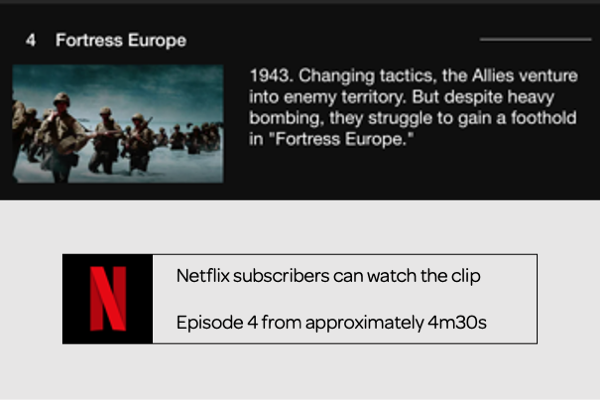
Ben Nemes: I have to say, for me as a punter watching that, the feeling you get is that it straddles epic feature film and documentary. It sits right where I think you intended it to. It’s factual, it’s real, it’s happening. But you did get a bit, kind of, you did get a bit Private Ryan about it at times as well. It’s really good!
There are some questions which we’ll come to in a second. I wanted to touch on music.
There’s lots of music in that scene. There’s lots of everything in that scene. How do you approach accommodating all those elements? And at what point do you get to know the scale of the task?
Do you have music to work with early on? Or does that come as something of a surprise when you think you’re home and dry?
Sophie-Alice Davies: Well actually, we originally worked a long time without the final music, and actually with temp music that came from films.
Ben Nemes: Right. So just some filmic music, stick it here, here and here?
Sophie-Alice Davies: Yeah. So normally you’d have the temp music that’s going to sound like the actual, or close to the actual, music.
So you can get an idea of where effects are going to be placed, or how effects are going to complement each other and the music. But in this case, we had to just put sound on all of it and wait for the music to come in and then readjust the sounds, how they sounded, what’s going to poke through.
And actually in this scene we had to get the composer back in to rework some of the music because where some explosions were hitting didn’t actually work where the music was hitting. And you know, if the music’s crescendoing there, maybe we need to put the explosion not there, but here.
So it got a little bit tricky. So ideally you’d want the temp music to sound like the actual music.
Ben Nemes: Well, oftentimes, the way you accommodate it is just by not having music? I think there’s a quote from David Arnold. I think he was working on a Bond movie and he said, they send you rushes, and the minute you see a helicopter crash, you think, “Great: Not got to do that!” Don’t need music, because you just think there’s no way you can accommodate all that.
But here you kind of have to, because the tension comes from both elements. And that, I guess is about music stems? It’s not an either/or anymore. It’s not just duck the music because there’s some fly pasts from planes. You want them both to contribute. Is that stems, is that EQ?
Sophie-Alice Davies: It can be various things. So if you’ve got an engine, rev, that gets muddied by the music. Then you either just pick another effect, add another effect that’s going to cut through, or add various effects to complement it. Or you can EQ the music as well. So let the other frequencies cut through.
Ben Nemes: So you’re kind of sculpting space?
Sophie-Alice Davies: You can momentarily knock out a bit of bass of the music to let the explosion cut through.
Ben Nemes: Or even, can you, if you know the cellos occupy that same space as the engine…
Sophie-Alice Davies: There is a lot of that as well. Yeah,
Luke Hatfield: David Schweitzer was the composer on this. He’s amazing. And even in that scene, some of his like synth-y sounds are similar to the rumble of the engines. That means that you can weave the sound effects and the music in and out of each other and, like, are you listening to music?Or is that a sound effect? It’s quite nice to be able to add those things in together.
Ben Nemes: I’ve got questions from the audience. Angela Jackson kindly asks, “To what extent was the original narrative found and matched up with footage, e. g. letters, diaries sent home with the footage?”
I think I know this question. I was talking to Marcus Stemler here, this time last year, here about All Quiet on the Western Front, and a lot of his decisions around sound effects choices and sound design, because there was so little archive from World War I, was from diaries. It was from accounts of people saying, at night when it went quiet, you could hear bodies rotting and stuff like that.
And he used all that to inform sound design, because he had so little archive. And I guess Angela’s question is, is to what extent do you rely on testimony to guide your choices in sound effects and sound design? I hope that’s right, Angela, if you’re out there? Yes, thank you.
Sophie-Alice Davies: I don’t know if I could in this one. I just listened to the stories. A lot of my research is what kind of planes were used during that war, or that battle. And I based it on those ideas.
Ben Nemes: This is everything you have to know. What’s that gun? What’s that tracked vehicle…
Luke Hatfield: All these things in your script writing of the walla.
Sophie-Alice Davies: The script writing of the walla was definitely based on the testimonies.
So I if could hear the other Germans shouting abuse I’d get the walla team to being saying those things based on their testimonies. It was more that stuff.
Ben Nemes: First you have to know what it is you’re looking at? Second you have to get some context around it, and that can only come from someone who was there, or someone who’s an expert in it? It can’t be left to you to decide what it would have been like?
Sophie-Alice Davies: We based it a lot on what the interviewee was saying. That’s where the script came from. And then it was more “What would they be saying?”.
I’d talk to the actors and say “You’re losing the fight. What would you be saying? What would you be shouting?”. Direction.
Luke Hatfield: And what would you be shouting in that time, as well. Swear words and cuss words now were not the same then. What would they be saying as their derogatory terms for the enemy. That context is important for us to get right.
Ben Nemes: One more question on the slido, then we’ll just check in the room if there’s any questions. Anonymous asks “Was there a sound which was particularly difficult to create?” Was there one stand-out thing that was the bane of your life?
Luke Hatfield: All of it!
Sophie-Alice Davies: Planes. I found the planes really hard. Because I wanted to keep it as true to how they would sound as possible, and that was challenging.
Ben Nemes: It’s funny ‘cos after you guys were describing it just then. That opening scene then with the B-17s, that metallic element to the engine sounds, the engine metal rattle. I hadn’t thought about it ’til you mentioned it, then you hear it, and it really sells it. You’re right, it’s got more to it.
Luke Hatfield: And even though this is a big-budget documentary, you have to remember the budget is a documentary budget. We don’t have infinite time to go out to airfields and do totally unique recordings. We just don’t have that luxury.
So it’s a question of having to source, and then Sophie – hours of cutting things together to get it to where we want it to be.
Ben Nemes: It doesn’t need that caveat “It’s a documentary budget”. It doesn’t look like it, it doesn’t sound like it. It’s an amazing piece of work.
Are there any questions in the room before we have to hand our stage back to somebody else?
[Audience Member]: Thanks for that, it’s really interesting. I was just wondering, if you weren’t able to go to airfields and do bespoke recordings of similar hardware, where did you source this stuff from?
Luke Hatfield & Sophie-Alice Davies: Lots and lots of libraries!
Luke Hatfield: Asoundeffect has great resources of different libraries. Some source recordings we’ve got:
At Vaudeville, we have an immersive library which we’ve done with Shutterstock.
Ben Nemes: And where would someone find that online?
Luke Hatfield: Shutterstock. If you type in ‘Immersive Sound Effects’ all the Vaudeville ones come up. Otherwise, all sorts of places.
Sophie-Alice Davies: Even Pond. They’re original recordings but, like I said, it wasn’t just the plane engine I put on, it was various layers to compliment them, and I treated them as well.
Ben Nemes: Thank you.
Well, for those of you who didn’t raise your hand at the beginning to say you’d seen it. My advice would be – if you haven’t been inspired by that anyway – watch it, it’s great. And watch it bearing in mind what went into it, cos it’s absolutely stunning.
So it remains just for me to thank Luke and thank Sophie for being with us this morning, and thank you all for coming.
Thanks to the Media Production & Technology Show, which returns to Olympia, London on the 14th and 15th May 2025.
